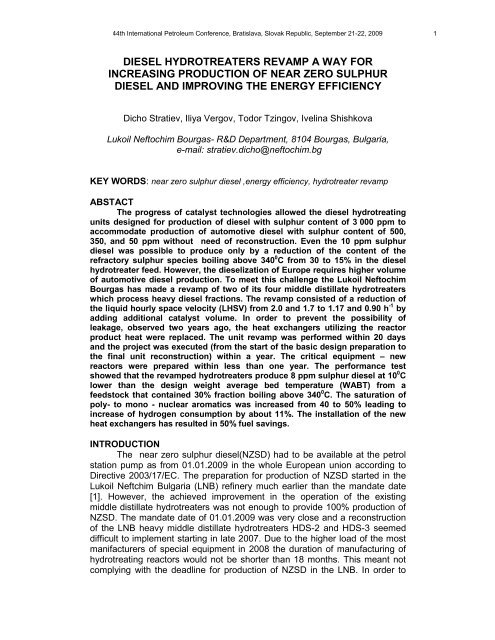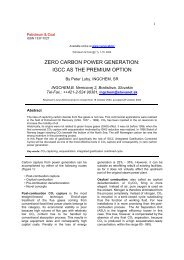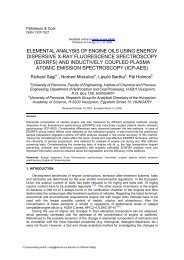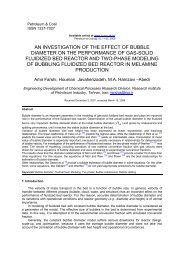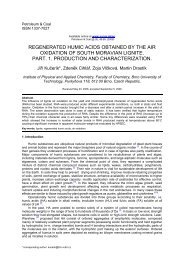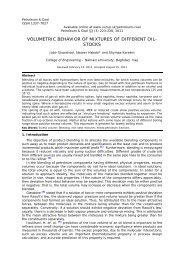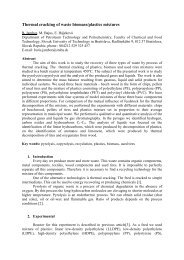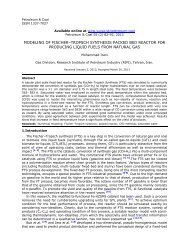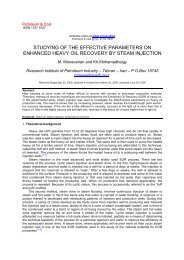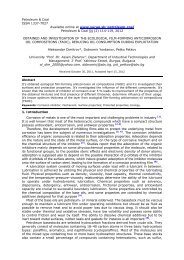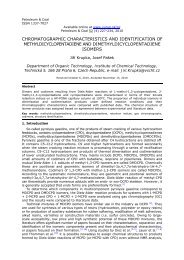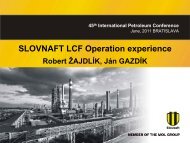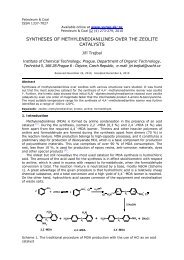diesel hydrotreaters revamp a way for increasing production
diesel hydrotreaters revamp a way for increasing production
diesel hydrotreaters revamp a way for increasing production
You also want an ePaper? Increase the reach of your titles
YUMPU automatically turns print PDFs into web optimized ePapers that Google loves.
44th International Petroleum Conference, Bratislava, Slovak Republic, September 21-22, 2009 1<br />
DIESEL HYDROTREATERS REVAMP A WAY FOR<br />
INCREASING PRODUCTION OF NEAR ZERO SULPHUR<br />
DIESEL AND IMPROVING THE ENERGY EFFICIENCY<br />
Dicho Stratiev, Iliya Vergov, Todor Tzingov, Ivelina Shishkova<br />
Lukoil Neftochim Bourgas- R&D Department, 8104 Bourgas, Bulgaria,<br />
e-mail: stratiev.dicho@neftochim.bg<br />
KEY WORDS: near zero sulphur <strong>diesel</strong> ,energy efficiency, hydrotreater <strong>revamp</strong><br />
ABSTACT<br />
The progress of catalyst technologies allowed the <strong>diesel</strong> hydrotreating<br />
units designed <strong>for</strong> <strong>production</strong> of <strong>diesel</strong> with sulphur content of 3 000 ppm to<br />
accommodate <strong>production</strong> of automotive <strong>diesel</strong> with sulphur content of 500,<br />
350, and 50 ppm without need of reconstruction. Even the 10 ppm sulphur<br />
<strong>diesel</strong> was possible to produce only by a reduction of the content of the<br />
refractory sulphur species boiling above 340 0 C from 30 to 15% in the <strong>diesel</strong><br />
hydrotreater feed. However, the <strong>diesel</strong>ization of Europe requires higher volume<br />
of automotive <strong>diesel</strong> <strong>production</strong>. To meet this challenge the Lukoil Neftochim<br />
Bourgas has made a <strong>revamp</strong> of two of its four middle distillate <strong>hydrotreaters</strong><br />
which process heavy <strong>diesel</strong> fractions. The <strong>revamp</strong> consisted of a reduction of<br />
the liquid hourly space velocity (LHSV) from 2.0 and 1.7 to 1.17 and 0.90 h -1 by<br />
adding additional catalyst volume. In order to prevent the possibility of<br />
leakage, observed two years ago, the heat exchangers utilizing the reactor<br />
product heat were replaced. The unit <strong>revamp</strong> was per<strong>for</strong>med within 20 days<br />
and the project was executed (from the start of the basic design preparation to<br />
the final unit reconstruction) within a year. The critical equipment – new<br />
reactors were prepared within less than one year. The per<strong>for</strong>mance test<br />
showed that the <strong>revamp</strong>ed <strong>hydrotreaters</strong> produce 8 ppm sulphur <strong>diesel</strong> at 10 0 C<br />
lower than the design weight average bed temperature (WABT) from a<br />
feedstock that contained 30% fraction boiling above 340 0 C. The saturation of<br />
poly- to mono - nuclear aromatics was increased from 40 to 50% leading to<br />
increase of hydrogen consumption by about 11%. The installation of the new<br />
heat exchangers has resulted in 50% fuel savings.<br />
INTRODUCTION<br />
The near zero sulphur <strong>diesel</strong>(NZSD) had to be available at the petrol<br />
station pump as from 01.01.2009 in the whole European union according to<br />
Directive 2003/17/EC. The preparation <strong>for</strong> <strong>production</strong> of NZSD started in the<br />
Lukoil Neftchim Bulgaria (LNB) refinery much earlier than the mandate date<br />
[1]. However, the achieved improvement in the operation of the existing<br />
middle distillate <strong>hydrotreaters</strong> was not enough to provide 100% <strong>production</strong> of<br />
NZSD. The mandate date of 01.01.2009 was very close and a reconstruction<br />
of the LNB heavy middle distillate <strong>hydrotreaters</strong> HDS-2 and HDS-3 seemed<br />
difficult to implement starting in late 2007. Due to the higher load of the most<br />
manifacturers of special equipment in 2008 the duration of manufacturing of<br />
hydrotreating reactors would not be shorter than 18 months. This meant not<br />
complying with the deadline <strong>for</strong> <strong>production</strong> of NZSD in the LNB. In order to
44th International Petroleum Conference, Bratislava, Slovak Republic, September 21-22, 2009 2<br />
find a solution in this tough situation the technological department and the<br />
research laboratory made estimation about the required catalyst volume<br />
increase necessary to achieve <strong>production</strong> of NZSD in the hydrotreating units<br />
HDS-2 and HDS-3 running on a mixture of heavy straight run gas oil and light<br />
vacuum gas oil from Ural crude. This estimation showed that the liquid hourly<br />
space velocity (LHSV) should be approximately 1.0h -1 if the mixture of heavy<br />
straight run gas oil and light vacuum gas oil from Ural crude is hydrotreated at<br />
a pressure of 35 kg/cm 2 on the Topsoe TK-576 Brim catalyst. This catalyst<br />
proved to be among the best per<strong>for</strong>mers in the ultra low hydrodesulphurization<br />
[1,2]. The LHSV of about 1.0h -1 was possible to achieve if reactors with<br />
dimensions of the LNB FCC feed hydrotreating reactors were installed in the<br />
HDS-2 and HDS-3 units. Drawings of these reactors were available and this<br />
gave the opportunity to shorten the time <strong>for</strong> their manufacture. The LNB<br />
signed a contract with the Haldor Topsoe (HTAS) <strong>for</strong> basic engineering of<br />
reactor section <strong>for</strong> reconstruction of the LNB HDS-2 and HDS-3 units in<br />
November 2007. In late November 2007 HTAS assured LNB that the LNB<br />
FCC feed hydrotreating reactors fit the reconstruction of the HDS-2 and HDS-<br />
3 units and LNB signed a contract <strong>for</strong> manifacturing of the hydrotreating<br />
reactors <strong>for</strong> a period of less than 12 months with the Russian company OOO<br />
Energomash-Atomash. Having the bitter experience with appearance of<br />
leakage in the heat exchangers LNB was aware that the <strong>production</strong> of NZSD<br />
could fail if the older heat exchangers were used [3]. That is why a contract<br />
with the Ukrain company OOO Mashzavod was signed <strong>for</strong> manufacturing of<br />
shell and tube heat exchangers <strong>for</strong> utilization of the energy of the reactor<br />
product stream effluent. The delivery term <strong>for</strong> the heat exchangers was lower<br />
than 12 months. With this tight schedule the HDS-3 was reconstructed and<br />
successfully started up operation in late December 2008.The HDS-2 unit was<br />
reconstructed and successfully started up operation in early March 2009. The<br />
aim of this work is to discuss the achieved operation of the reconstructed LNB<br />
heavy middle distillate hydrotreating HDS-2 and HDS-3 units.<br />
EXPERIMENTAL<br />
The per<strong>for</strong>mance test of the reconstructed LNB HDS-3 was carried out in<br />
December 2008 at following conditions:<br />
- Feedstock properties<br />
Density at 15 °C, kg/m3 851.6-853.5<br />
Distillation, ASTM D 86, o C<br />
- IBP 208-220<br />
- 10% vol% 257-265<br />
- 50% vol% 294-300<br />
- 90% vol% 330-340<br />
- 95% vol% 338-349<br />
- EBP 355-360<br />
Sulfur , wt% 0.66-0.875<br />
Bromine number, g Br2/100 g 0.9-2.8<br />
Total aromatics,% 27.4-29.2<br />
Polynuclear aromatics , % 8.8-9.7
44th International Petroleum Conference, Bratislava, Slovak Republic, September 21-22, 2009 3<br />
- Unit operating conditions:<br />
LHSV, h -1<br />
0.90<br />
First reactor inlet temperature, ºC 350<br />
First reactor outlet temperature, ºC 362<br />
Second reactor inlet temperature, ºC 360<br />
Second reactor inlet temperature, ºC 362<br />
Hydrogen/Oil ratio, Nm 3 /m 3 230<br />
Hydrogen make-up, Nm 3 /m 3 66<br />
Hydrogen content in the make up gas, mole% ≥ 80<br />
The per<strong>for</strong>mance test of the reconstructed LNB HDS-2 was carried out in<br />
March 2009 at following conditions:<br />
- Feedstock properties<br />
Density at 15 °C, kg/m3 854,6-860,9<br />
Distillation, ASTM D 86, o C<br />
- IBP 179-219<br />
- 10% vol% 233-252<br />
- 50% vol% 294-302<br />
- 90% vol% 340-349<br />
- 95% vol% 351-360<br />
- EBP 360<br />
Sulfur , wt% 0.983-1.12<br />
Nitrogen , mg/kg 164 -266<br />
Bromine number, g Br2/100 g 3.35 - 5.68<br />
Total aromatics,% 29.6<br />
Polynuclear aromatics , % 11.1<br />
- Unit operating conditions:<br />
LHSV, h -1<br />
1.17<br />
First reactor inlet temperature, ºC 349<br />
First reactor outlet temperature, ºC 374<br />
Second reactor inlet temperature, ºC 372<br />
Second reactor inlet temperature, ºC 374<br />
Hydrogen/Oil ratio, Nm 3 /m 3 284<br />
Hydrogen make-up, Nm 3 /m 3 76<br />
Quench, Nm 3 /m 3 10<br />
Hydrogen content in the make up gas, mole% 79.5-86
44th International Petroleum Conference, Bratislava, Slovak Republic, September 21-22, 2009 4<br />
RESULTS AND DISCUSSION<br />
During the per<strong>for</strong>mance test of the HDS-3 unit the product (stable<br />
hydrogenate) properties were as follows:<br />
- Product properties<br />
Sulphur , wt ppm ≤ 5<br />
Density at 15 °C, kg/m 3 840.5-843.6<br />
Polynuclear aromatics , % 4.6-5.8<br />
These data indicate that the increase of the catalyst volume by a factor<br />
of 1.9 (decreasing the LHSV from 1.7 to 0.90h -1 ) allowed the LNB heavy<br />
middle distillate hydrotreater HDS-3 to produce NZSD. The hydrogen<br />
consumption was found to be 28.3 Nm 3 /m 3 oil which was 8% higher than that<br />
recorded be<strong>for</strong>e the reconstruction (26.3 Nm 3 /m 3 oil).<br />
During the per<strong>for</strong>mance test of the HDS-2 unit the product (stable<br />
hydrogenate) properties were as follows:<br />
- Product properties<br />
Sulphur , wt ppm ≤ 5<br />
Density at 15 °C, kg/m 3 844-845<br />
Polynuclear aromatics , % 4.6-5.8<br />
These data indicate that the increase of the catalyst volume by a factor<br />
of 1.7 (decreasing the LHSV from 2.0 to 1.17h -1 ) allowed the LNB heavy<br />
middle distillate hydrotreater HDS-2 to produce NZSD. The hydrogen<br />
consumption was found to be 34.2 Nm 3 /m 3 oil which was 14% higher than that<br />
recorded be<strong>for</strong>e the reconstruction (30.1 Nm 3 /m 3 oil).<br />
Figures 1 and 2 present the deactivation of the catalyst TK-576 Brim in<br />
the LNB HDS-3 and HDS-2 heavy middle distillate <strong>hydrotreaters</strong>. It is evident<br />
from these data that the catalyst in HDS-2 unit has exhibited higher<br />
deactivation rate of 3.4 0 C/month, than HDS-3 catalyst whose deactivation rate<br />
is 3.0 0 C/month. With a start of run temperature (SORT) of 350 0 C and end of<br />
run temperature (EORT) of 390 0 C a cycle length of 13 months is obtained <strong>for</strong><br />
HDS-3. With a start of run temperature (SORT) of 349 0 C and end of run<br />
temperature (EORT) of 390 0 C also a cycle length of 12 months is obtained <strong>for</strong><br />
HDS-2. The replacement of the older heat exchangers in both units not only<br />
improved reliability but also improved the unit energy efficiency. The cost <strong>for</strong><br />
fuel gas was reduced by a factor of two.
O C<br />
400<br />
395<br />
390<br />
385<br />
380<br />
375<br />
370<br />
365<br />
360<br />
355<br />
350<br />
345<br />
340<br />
335<br />
330<br />
325<br />
320<br />
315<br />
310<br />
305<br />
300<br />
44th International Petroleum Conference, Bratislava, Slovak Republic, September 21-22, 2009 5<br />
WABTreal WABTnorm Product suphur<br />
0 10 20 30 40 50 60 70 80 90 100 110 120 130 140 150 160 170 180 190 200 210 220 230 240 250<br />
Days of Run<br />
Figure 1 Deactivation of the catalyst TK-576 Brim in the LNB HDS-3 unit<br />
Deactivation rate - 3.0 o C/month<br />
50<br />
45<br />
40<br />
35<br />
30<br />
25<br />
20<br />
15<br />
10<br />
5<br />
0<br />
Product sulphur, ppm
О С<br />
400<br />
395<br />
390<br />
385<br />
380<br />
375<br />
370<br />
365<br />
360<br />
355<br />
350<br />
345<br />
340<br />
335<br />
330<br />
325<br />
320<br />
315<br />
310<br />
305<br />
44th International Petroleum Conference, Bratislava, Slovak Republic, September 21-22, 2009 6<br />
WABT real WABT norm Product sulphur<br />
300<br />
0<br />
0 10 20 30 40 50 60 70 80 90 100 110 120 130 140 150 160 170 180<br />
Days of Run<br />
Figure 2 Deactivation of the catalyst TK-576 Brim in the LNB HDS-2 unit<br />
Deactivation Rate - 3.4 o C/month<br />
50<br />
45<br />
40<br />
35<br />
30<br />
25<br />
20<br />
15<br />
10<br />
5<br />
Product sulphur, ppm
44th International Petroleum Conference, Bratislava, Slovak Republic, September 21-22, 2009 7<br />
CONCLUSIONS<br />
The design and construction of the <strong>revamp</strong> of the LNB heavy middle<br />
distillate hydrotreating units HDS-2 and HDS-3 was implemented <strong>for</strong> a record<br />
short time of 12 months due to the well organized and coordinated work<br />
between the Lukoil Chief engineer department, the licensor of technology<br />
Haldor Topsoe and the manufacturer of reactors and heat exchangers the<br />
Russian company OOO Energomash-Atomash and the Ukrain company OOO<br />
Mashzavod. The units were put on stream according to the planned schedule<br />
and demonstrated stable operation with an expected catalyst cycle length of<br />
12-13 months.<br />
REFERENCE<br />
[1] I. Vergov, I. Shishkova, “Catalyst advances promote <strong>production</strong> of near<br />
zero sulphur <strong>diesel</strong>”, Petroleum & Coal, 51 (2), pp. 136-139, 2009.<br />
[2] D. Stratiev, V. Galkin, K. Stanulov, “Study: Most-active catalyst<br />
improves ULSD economics”, Oil&Gas Journal, Aug.14, pp. 53-56, 2006.<br />
[3] D. Dobrev, D. Stratiev, T. Tzingov, G. Argirov, V. Dyakov, P. Petkov,<br />
“Effect of unreliable <strong>diesel</strong> hydrodesulphurization unit equipment operation<br />
on the <strong>production</strong> of ultra low sulphur <strong>diesel</strong>”, Proc. 43 th International<br />
Petroleum Conference, 2007, Bratislava, Slovac Republic.


